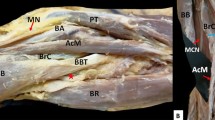Abstract
The hypothenar hammer syndrome (HHS) is a rare entity of secondary Raynaud’s phenomenon. The blunt hypothenar trauma causes a lesion of the vessel wall with a consecutive thrombosis or aneurysm of the ulnar artery at the Guyon’s canal. Different risk factors are discussed such as nicotine abuse, or a muscle anomaly in the Guyon’s canal. To date, there are five case reports published about muscle anomalies and HHS. We present a case of a 51-year-old shipbuilder with a unilateral HHS on his right dominant hand with a bilateral muscle anomaly. We successfully treated the patient by resection of the aneurysm without a resection of the atypical muscle.



Similar content being viewed by others
References
Carneirio RS, Mann RJ (1979) Occlusion of the ulnar artery associated with an anomalous muscle: a case report. J Hand Surg Am 4(5):412–414
Conn J Jr (1970) Hypothenar hammer syndrome: posttraumatic digital ischemia. Surgery 68:1122–1128
de Niet A, Van Uchelen JH (2017) Hypothenar hammer syndrome: long-term follow-up after ulnar artery reconstruction with the lateral circumflex femoral artery. J Hand Surg Eur Vol 42(5):507–510
Depukat P, Henry BM, Popieluszko P et al (2017) Anatomical variability and histological structure of the ulnar nerve in the Guyon’s canal. Arch Orthop Trauma Surg 137(2):277–283
Dethmers R, Houpt P (2005) Surgical management of hypothenar and thenar hammer syndromes: a retrospective study of 31 instances in 28 patients. J Hand Surg Br 30(4):419–423
Dodds GA, Hale D, Jackson WT (1990) Incidence of anatomic variants in Guyon’s canal. J Hand Surg Am 15(2):352–355
Iannuzzi NP, Higgins JP (2015) Acute arterial thrombosis of the hand. J Hand Surg Am 40(10):2099–2106
Larsen BT, Edwards WD, Jensen MH et al (2013) Surgical pathology of hypothenar hammer syndrome with new pathogenetic insights: a 25-year institutional experience with clinical and pathologic review of 67 cases. Am J Surg Pathol 37(11):1700–1708
Lawhorne TW, Sanders RA (1986) Ulnar artery aneurysm complicated by distal embolization: management with regional thrombolysis and resection. J Vasc Surg 3(4):663–665
Marie I, Hervé F, Primard E, Cailleux N, Levesque H (2007) Long-term follow-up of hypothenar hammer syndrome: a series of 47 patients. Medicine 86(6):334–343
Müller L, Kreitner K, Seidl C, Degreif J (1997) Traumatic thrombosis of the distal ulnar artery (Hypothenar-Hammer syndrome) in a golfplayer with an anomalous muscle in Guyon’s space. Handchir Mikrochir Plast Chir 29:183–186
Pierre-Jerome C, Moncayo V, Terk MR (2011) The Guyon’s canal in perspective: 3-T MRI assessment of the normal anatomy, the anatomical variations and the Guyon’s canal syndrome. Surg Radiol Anat 33(10):897–903
Pribyl CR, Moneim MS (1994) Anomalous hand muscle found in the Guyon’s canal at exploration for ulnar artery thrombosis: a case report. Clin Orthop Relat Res 306:120–123
Stone JR (2004) Intimal hyperplasia in the distal ulnar artery. Cardiovasc Pathol 13(1):20–25
Temming JF, van Uchelen JH, Tellier MA (2011) Hypothenar hammer syndrome: distal ulnar artery reconstruction with autologous descending branch of the lateral circumflex femoral artery. Tech Hand Up Extrem Surg 15(1):24–27
Von Kuster L, Abt A (1980) Traumatic aneurysms of the ulnar artery. Arch Pathol Lab Med 104(2):75–78
Von Rosen S (1934) A case of thrombosis in the artery ulnaris after trauma. Acta Chir Scand 73:500–506
Walgenbach KJ, Krishnamurthy A, Walgenbach-Brünagel G, Lee WPA (2009) An anomalous muscle predisposing to the development of hypothenar hammer syndrome. Plast Reconstr Surg 124(2):197e-199e
Weeks PM, Young LV (1982) Ulnar artery thrombosis and ulnar nerve compression associated with an anomalous hypothenar muscle. Plast Reconstr Surg 69(1):130–131
Wulle C (1987) M. abductor digiti minimi longus: anatomical rarity? Handchir Mikrochir Plast Chir 19(1):43–45
Zeiss J, Jakab E, Khimji T, Imbriglia J (1992) The ulnar tunnel at the wrist (Guyon’s canal): normal MR anatomy and variants. AJR Am J Roentgenol 158(5):1081–1085
Funding
No funding has been obtained for this study.
Author information
Authors and Affiliations
Corresponding author
Ethics declarations
Conflict of interest
The authors declare that they have no conflict of interest.
Ethical approval
Ethical approval is not required.
Informed consent
Informed consent has been obtained from the patient included in this study.
Rights and permissions
About this article
Cite this article
Estermann, L., Ducommun, P., Steurer-Dober, I. et al. Hypothenar hammer syndrome: caused by a muscle anomaly? A case report with review of the literature. Arch Orthop Trauma Surg 138, 739–742 (2018). https://doi.org/10.1007/s00402-018-2913-1
Received:
Published:
Issue Date:
DOI: https://doi.org/10.1007/s00402-018-2913-1




